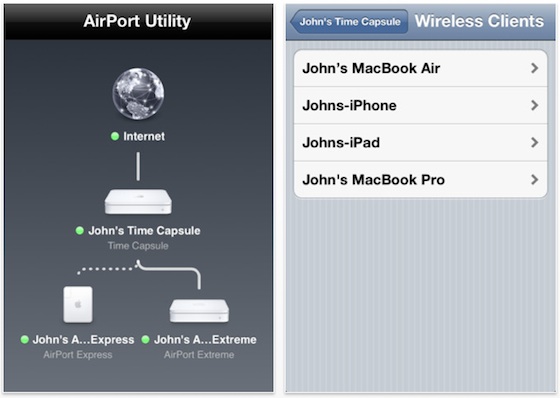

- USE MAC AIRPORT UTILITY PC FOR MAC OS
- USE MAC AIRPORT UTILITY PC MANUAL
- USE MAC AIRPORT UTILITY PC WINDOWS 10
- USE MAC AIRPORT UTILITY PC PASSWORD
I have attached to it an 8 TB USB drive that is serving both as a Time Machine destination, as well as normal file sharing. It also has Time Capsule features built-in, in case you're wondering. I have on my home network an Apple Airport Express A1521 - the 6th generation Airport Express. Given that these two pieces of advice conflicted, I thought to check it out. While SMB1 can be enabled, it is strongly recommended to not do so because of severe security risks.
USE MAC AIRPORT UTILITY PC WINDOWS 10
Out of the box, Windows 10 does not support the SMB1 protocol used on Time Capsule devices. They also suggest starting a command shell and typing ping #.#.#.# to make sure that your Windows PC can reach the Time Capsule. Since that's a really bad horrid computer virus, you really don't want to leave your computer open to that vulnerability.īut many postings I found suggest that you can manually Map Network Drive and give the IP address ( \\#.#.#.#\shareName) or give the server name ( \\server-name\shareName) to map the drive. Some point out that Windows 10 no longer supports (out of the box) NAS services based on the SMB1 protocol, because using SMB1 leaves your computer open to the Wannacry attack. A search for use apple time capsule from windows turns up a number of articles with differing opinions.
USE MAC AIRPORT UTILITY PC PASSWORD
To authenticate the SMB client for access to the Time Capsule when you have not set up individual users on the Time Capsule, you can use any (non-blank) username (it is ignored) as long as the password is correct.Unfortunately it's not hard to find incorrect advice on this issue. The default workgroup name of "WORKGROUP" is the easiest way to go. You also want to assign it to a Workgroup if you're using SMB and you want your Linux and Windows machine and the Time Capsule to all be in the same workgroup. With Time Capsule firmware version 7.6 and later you have 3 choices for password protection: you can use the same password for file sharing that you use fo Time Capsule, you can use a different password, or you can go all out and set up multiple users, each with their own password (and corresponding ownership and permissions features). Now select the File Sharing panel to get to the rest of the configurations you need to set. You should avoid hyphens, too, as sometimes hyphens are converted to spaces and sometimes spaces are converted to hyphens and it just gets unnecessarily confusing. This partition name is the root directory name for the SMB share, so make it short and without spaces. (Click on the triangle next to "Time Capsule Disk" if you don't see a partition name under it.) Click on the partition name an the right panel changes to show you information about it, including giving you the ability to change its name. My Time Capsule just has the internal drive with one partition. Note that like Disk Utility, the list is hierarchical, with drive partitions listed under drive devices. That should present you with the "Disks" pane, which should list the disks in and attached to the Time Capsule.
USE MAC AIRPORT UTILITY PC MANUAL
From the AirPort Utility, select the Time Capsule, select Manual Setup, click on the Disks tab. You need to explicitly enable File Sharing on the Time Capsule using the AirPort Utility.

Airport Utility 6.0 is greatly simplified and missing a ton of features that were available in 5.6. If your are on Snow Leopard or earlier, you probably already have 5.6. You can download Airport Utility 5.6 from Apple. If you are running Lion, 6.0 is installed by default but you can have both installed on your Mac and use both. Note that the following setup assumes you are using Airport Utility 5.6 or later but NOT Airport Utility 6.0. You can, however, mount the Time Capsule's disk drive as a file share using either AFP or SMB and use any program that will back up files to a file share, which is almost any program that backs up to disk, although beware of possible issues relating to ownership and permissions and unflushed buffers.
USE MAC AIRPORT UTILITY PC FOR MAC OS
Super highly unlikely you'll find something like Time Machine, as that relies on file-system event logging that was custom made by Apple for Mac OS X.


 0 kommentar(er)
0 kommentar(er)
